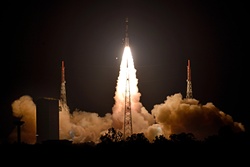Indian Space Research Organisation (Isro) today successfully launched navigation satellite INRSS-1I aboard its Polar Satellite Launch Vehicle (PSLV) from the Satish Dhavan Space Centre (SDSC), at Sriharikota, in Andhra Pradesh.

PSLV-C41/IRNSS-1I mission blasted off at 4.04 am from the first launch pad at the SDSC and injected the satellite into the designated orbit 19 minutes after lift-off, paving the way for India establishing its own satellite navigation system.
“After a flight lasting about 19 minutes, the vehicle achieved a sub-geosynchronous transfer orbit with a perigee (nearest point to earth) of 281.5 km and an apogee (farthest point to earth) of 20,730 km inclined at an angle of 19.2 degree to the equator, following which IRNSS-1I separated from PSLV," Isro stated in a statement.
It added, “After separation, the solar panels of IRNSS-1I were deployed automatically. Isro's Master Control Facility (MCF) at Hassan, Karnataka took over control of the satellite. In the coming days, the MSF will perform orbit manoeuvres to position the satellite at 55 deg east longitude in the planned geosynchronous orbit with an inclination of 29 deg to the equator."
IRNSS-1I is the latest member of the ‘Navigation with Indian Constellation (NavIC)’ system. NavIC, also known as Indian Regional Navigation Satellite System (IRNSS), is an independent regional navigation satellite system designed to provide position information in the Indian region and 1,500 km around the Indian mainland.
It was a normal lift-off, Isro officials said. Isro chairman K Sivan described the mission as a success and congratulated the scientists behind it.
"I am extremely happy to announce that the 8th navigation satellite of India was launched successfully into the NAVIC constellation. We are moving towards a major goal. This NAVIC constellation will create history," the Isro chairman said after the launch.
IRNSS-1I is expected to replace IRNSS-1A, the first of the seven navigation satellites that was rendered ineffective after its three rubidium atomic clocks failed. The seven satellites are part of the NavIC navigation satellite constellation.
The launch is Isro's second attempt at sending a replacement satellite.
The previous mission of a PSLV carrying IRNSS-1H in August last year failed after the heat shield covering the satellite failed to separate (
See:
Isro's IRNSS satellite launch fails).
A number of ground facilities responsible for IRNSS satellite ranging and monitoring, generation and transmission of navigation parameters, satellite control, network timing, etc, have been established in many locations across the country as part of NavIC.
Currently, only the US and Russia have fully operational GPS systems, while China and Europe are still deploying their own full systems. A native satellite-based navigation system is considered to be a deep strategic asset, useful in civilian and military fields.
The need for an indigenous GPS in India was identified after the Kargil conflict when India desperately needed services of satellite-based navigation system but did not have one of its own.
Till now, PSLV has successfully launched 52 Indian satellites and 237 satellites for foreign customers.
 PSLV-C41/IRNSS-1I mission blasted off at 4.04 am from the first launch pad at the SDSC and injected the satellite into the designated orbit 19 minutes after lift-off, paving the way for India establishing its own satellite navigation system.
PSLV-C41/IRNSS-1I mission blasted off at 4.04 am from the first launch pad at the SDSC and injected the satellite into the designated orbit 19 minutes after lift-off, paving the way for India establishing its own satellite navigation system.



















